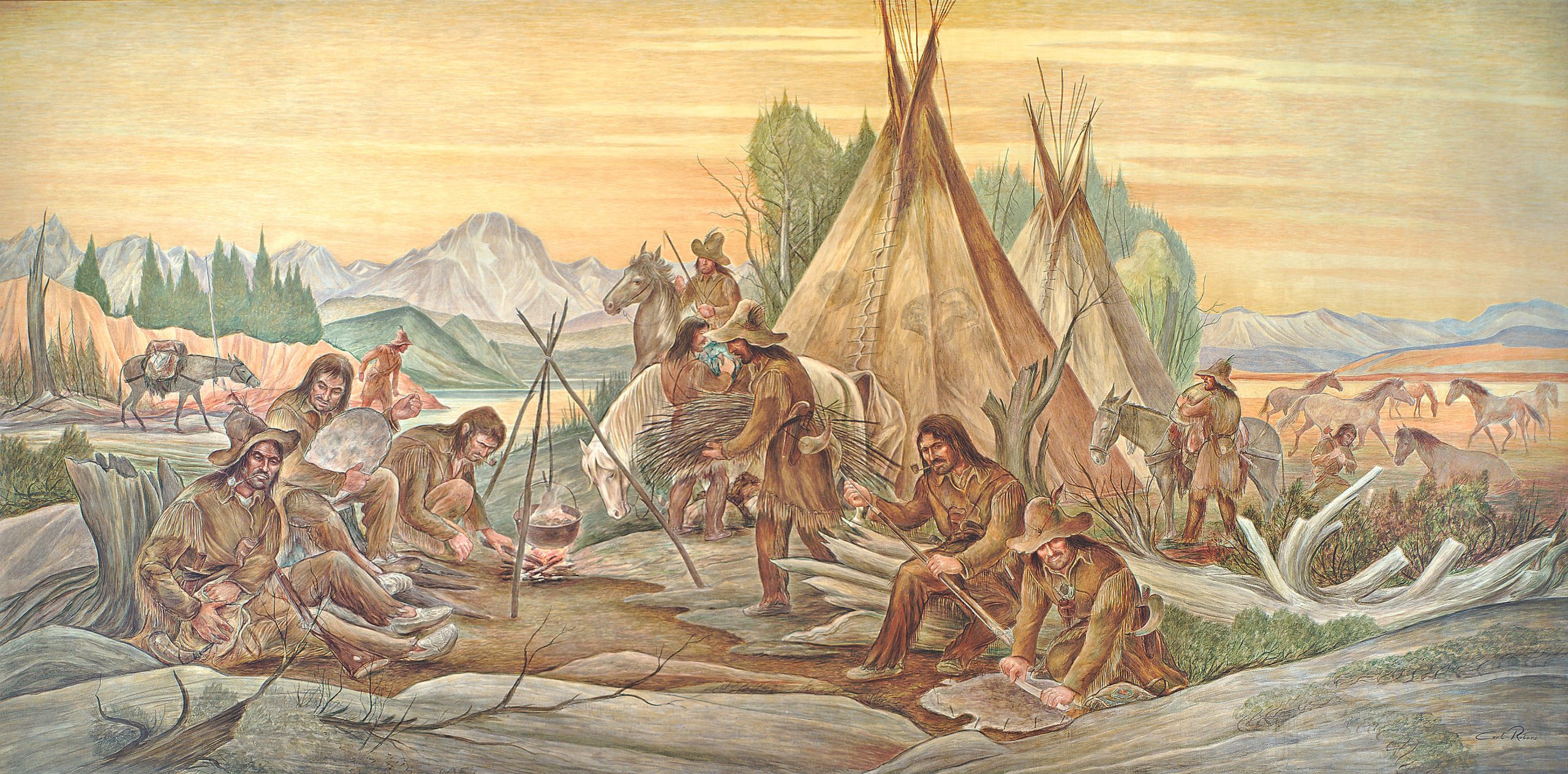
In the 1950s fortuitous events brought together the history of the “mountain man,” the vision of John D. Rockefeller, Jr., and the talent of artist Carl Roters, resulting in the creation of the Rendezvous Murals.
During the first part of the 19th century, mountain men and Indians combed the river valleys and creeks of the Rocky Mountains, trapping beaver to supply wealthy Americans and Europeans with exclusive top hats made from beaver fur. At an annual gathering called a “Rendezvous,” fur-trading companies brought supplies for trappers, who in turn sold their beaver pelts to the companies.
John D. Rockefeller, Jr., sponsored a competition to paint murals for his newly built Jackson Lake Lodge. Rockefeller chose “The Fur Traders and Trappers of the Early West” as the murals’ theme, recalling the mountain-man period begun in the wake of the Lewis and Clark expedition.
Carl Roters, a professor of art at Syracuse University in New York, won the Rockefeller commission. The Rendezvous Murals were painted between 1957 and 1959 and installed in the dining room of the lodge, where they are now viewed each year by thousands of visitors to Grand Teton National Park.
The two murals are made up of ten panels illustrating events and participants of the 1837 Rendezvous. They span two walls of the dining room and total nearly eighty feet in length.
Arrival Of Supply Caravan At Fort William
Fort William (also called Ft Laramie) located eight hundred miles from Westport, Missouri, was an important stop along the way to the Rendezvous site. The three central figures on horseback are (left to right) Thomas Fitzpatrick, the caravan's leader, Jim Bridger, head of field trapping operations for the American Fur Company, and Captain William Drummond Stewart.

Trapper Encampment in Jackson Hole
This panel depicts typical camp activities of a fur trapping brigade. Mountain men are shown scraping a beaver pelt, cleaning a rifle, tending a cooking fire, and loading pack mules. The dress and teepee lodges are historically accurate. Mt Moran and the Teton Cathederal Group are in the background.

Adventurer Captain William Drummond Stewart and Artist Alfred Jacob Miller
Captain William Drummond Stewart was a Scottish adventurer who attended six Rendezvous. He traveled with the supply caravan accompanied by several of his own hired hands. Alfred Jacob Miller was hired by Steward to chronicle his journey to the 1837 Rendezvous. Mill was the 1st artist to travel west of the Continental Divide and brought back images of a land never before seen by his fellow Americans.

Trapper Joe Meek
Joe Meek was second in command to Jim Bridger, managing field trapping operations for the American Fur Company.

Supply Caravan Leader Thomas Fitzpatrick
Thomas Fitzpatrick was the leader of the American Fur Company supply caravan that traveled round-trip from Missouri to the Rendezvous.
Fording The River
The supply caravan had to cross several rivers on its round-trip journey. To ford a river that was deeper than the height of the wagon floor, the wagons were unloaded, dismantled, and wrapped in buffalo hides, so that the supplies could be floated across.

Supply Caravan Subcommander Etienne Provost and Stewart’s Hired Hand Pierre
Etienne Provost was second in command to Thomas Fitzpatrick, leader of the supply caravan. Provost was known for riding a mule. Provo, Utah is named after him. The lower figure is a representation of a generic mountain man. Although Roters referred to this figure as “Pierre’” he appears to be based on one of Stewart’s hired hands known as Auguste.

Trapper Leader Jim Bridger and Snake Chief Ma-wo-ma
Jim Bridger, one of the most famous mountain men, managed trapper brigades in the field. Chief Ma-wo-ma was the leader of several thousand Snake Indians (Shoshone tribe).

Hunter Antoine Clement
Antoine Clement was hired by Captain Stewart as the chief hunter for his party. Clement also supervised Stewart’s other hired hands.



